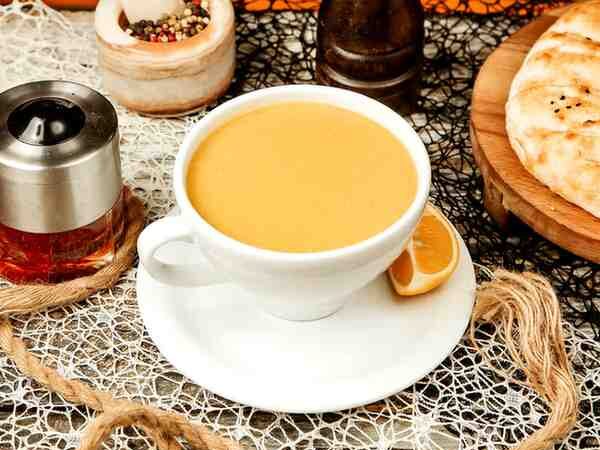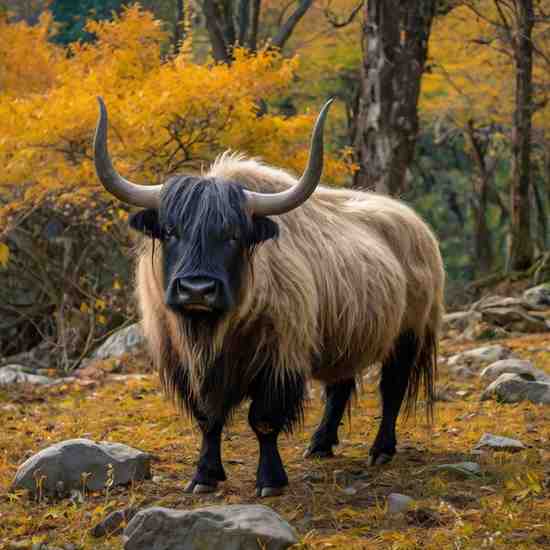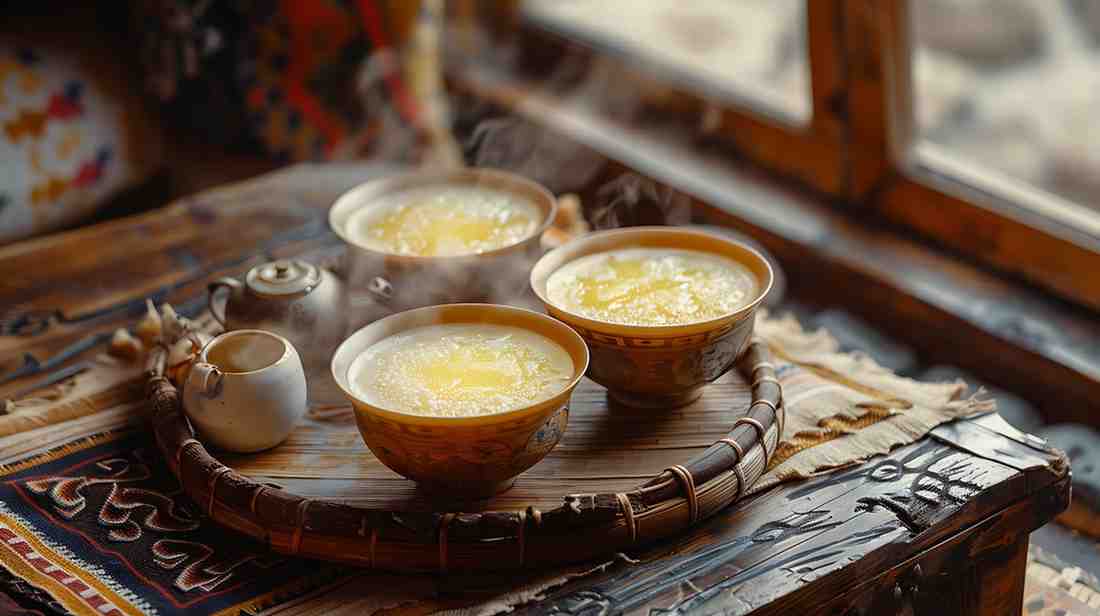Butter tea, known as Po Cha in Tibetan, is a unique and culturally significant drink from the Himalayan region. It is made from a blend of strong tea, yak butter, and salt, creating a rich, savory taste. This creamy beverage has been a staple for centuries, offering nourishment and warmth to those living in the high-altitude, cold climates of Tibet and beyond. Butter tea holds a deep connection to Tibetan culture and traditions, serving as a symbol of hospitality and resilience in challenging environments.
- Distinctive Ingredients: Made from brick tea, yak butter, water, and Himalayan salt.
- Rich Flavor: Offers a savory, warming taste that is often compared to broth.
- Essential in Tibetan Life: Supports physical and cultural needs in the harsh Himalayan climate.
The Origins and History of Butter Tea
The history of butter tea stretches back over a thousand years. Its origins lie in the Tibetan plateau, where it evolved as a practical drink for survival in harsh environments. Over time, butter tea has become a symbol of Tibetan identity and culture.
Historical Roots in Tibet
Butter tea originated in Tibet, where it quickly became an essential part of daily life. Tibetan communities embraced this beverage for its ability to provide energy and warmth in the high-altitude regions of the Himalayas.
- Staple of Tibetan Life: Tibetans relied on butter tea to maintain body heat and stamina during harsh winters. The tea’s rich, fatty base provided essential energy for enduring the cold and physical labor.
- Cultural Role: Beyond sustenance, butter tea became a symbol of Tibetan hospitality, offered to guests as a warm gesture of welcome. The drink’s warming spices, like cinnamon and ginger, are also reflected in traditional treats, such as sweet biscuits inspired by its flavors.
- Ancient Trade Routes: Butter tea spread through the Tea Horse Road, connecting Tibet with neighboring regions like Nepal and India. This ancient network helped embed the tea’s rich cultural significance across diverse communities.
The preparation of butter tea requires skill and care, using strong, smoky brick tea as the base. This tea, combined with yak butter and salt, creates a rich and hearty drink that sustains those who live in the challenging Tibetan plateau.
Influence of the Himalayan Region
Butter tea’s influence extends beyond Tibet, spreading to neighboring Himalayan communities like Nepal, Bhutan, and Northern India. These regions adapted the recipe, making it their own while keeping its core ingredients and purpose intact.
- Spread to Nepal and Bhutan: In Nepal and Bhutan, butter tea is known as “Suja.” These communities adopted the drink, using local variations of tea and butter. The preparation methods often reflect regional preferences.
- Adaptations of the Recipe: In areas without access to yak butter, people began using cow’s butter as a substitute. This adaptation allowed the tradition of butter tea to continue in regions where yak herding was less common.
- Enduring Tradition: Despite regional variations, the essence of butter tea remains the same—providing warmth, energy, and a sense of connection to the Himalayan way of life.
These regional adaptations illustrate how butter tea has evolved while retaining its cultural significance, reflecting the resilience and adaptability of the Himalayan people.

Cultural Importance of Butter Tea
Butter tea holds a special place in Tibetan culture, playing a role in both everyday life and spiritual practices. It is more than just a drink—it embodies the warmth, hospitality, and community spirit of Tibetan society.
Role in Tibetan Hospitality and Rituals
In Tibet, offering butter tea to guests is a gesture of respect and generosity. The act of sharing tea strengthens bonds between hosts and visitors, making it a fundamental part of social interactions.
- Symbol of Hospitality: When guests visit a Tibetan home, the host traditionally serves them a bowl of warm butter tea. This simple act shows care and makes guests feel welcome.
- Spiritual Significance: Butter tea also plays a role in Tibetan religious ceremonies. Monks use it as part of offerings in Buddhist rituals, symbolizing purity and devotion. It is often placed on altars during prayers.
- Daily Routines of Monks: In Tibetan monasteries, monks rely on butter tea for energy during long meditation sessions. The tea sustains them, helping them maintain focus and stay warm in the cold monastery halls.
Through its use in rituals and everyday hospitality, butter tea reflects the deep-rooted values of Tibetan culture. It emphasizes community, respect, and a connection to spiritual traditions.
Daily Life in Tibetan Communities
For Tibetan people, butter tea is an integral part of daily life. Its high-calorie content and warming properties make it essential for survival in the cold, high-altitude environment.
- Source of Energy: The combination of tea and butter provides a steady source of energy. It helps Tibetans endure physical labor, from tending to yak herds to managing daily chores in the rugged terrain.
- Maintains Body Warmth: The fat from yak butter helps maintain body heat, making it easier to cope with freezing temperatures. Drinking butter tea throughout the day keeps the body warm and resilient against the elements.
- Social Connection: Butter tea is often shared among family members during meals or community gatherings. It serves as a moment of togetherness, bringing people together to enjoy a warm cup while exchanging stories and news.
Butter tea’s role in Tibetan life goes beyond mere sustenance—it fosters social connections and offers comfort in a challenging environment.
Tibetan Butter Tea Recipe
Making traditional Tibetan butter tea requires specific ingredients and methods to achieve its distinctive taste and texture. While the original recipe uses yak butter, modern adaptations allow for different variations depending on ingredient availability.
Traditional Recipe for Po Cha
Traditional Po Cha relies on simple but rich ingredients. The process involves blending strong tea, yak butter, and salt to create a creamy, savory drink.
- Key Ingredients:
- Brick Tea: Traditionally, Tibetans use a potent, smoky black tea that forms the base of Po Cha.
- Yak Butter: This ingredient gives the tea its rich, creamy texture. It provides the calories needed for high-altitude living.
- Himalayan Salt: Adds a touch of flavor and helps with hydration.
- Preparation Method:
- Boil the brick tea in water until it becomes strong and concentrated.
- Combine the brewed tea with a few tablespoons of yak butter and salt in a special churn or blender.
- Blend or churn the mixture until it reaches a smooth, creamy consistency.
- Tips for the Best Results: To achieve the perfect texture, ensure the butter melts fully into the tea. Adjust the salt to taste for a balanced flavor.
This traditional preparation method results in a thick, frothy tea that is deeply nourishing. It serves as a reminder of the rich heritage and craftsmanship of Tibetan tea-making.
Modern Adaptations of the Recipe

As butter tea has spread beyond Tibet, many people have adapted the recipe to suit local ingredients and tastes. These variations make it possible to enjoy butter tea no matter where you live.
- Using Cow’s Butter: In areas without access to yak butter, cow’s butter offers a suitable alternative. Although it slightly changes the flavor, it still delivers a creamy, rich taste.
- Variations for Different Tastes: Some people add a splash of milk or cream to soften the tea’s flavor. Others might include spices like cinnamon or cardamom for a new twist on the traditional recipe.
- Preparing Butter Tea with Tea Bags: For a quicker version, you can use strong black tea bags or loose-leaf tea instead of brick tea. Simply brew the tea and blend it with butter and salt.
These modern adaptations ensure that the tradition of butter tea can continue, allowing more people to experience its warmth and comfort.
The Health Benefits of Butter Tea
Butter tea, with its unique blend of tea, butter, and salt, offers several health benefits that are especially useful in high-altitude environments. Beyond nourishment, it provides warmth, energy, and hydration, making it a vital drink for those living in the Himalayas.
Nutritional Value of Po Cha
Butter tea is rich in calories, fats, and essential nutrients. These elements make it an energy-dense beverage that supports the demanding lifestyle of Tibetan communities.
- High-Calorie Content: The tea’s combination of butter and tea delivers a concentrated source of calories. This helps Tibetan people maintain energy during physically demanding tasks and withstand the cold climate.
- Healthy Fats from Yak Butter: Yak butter, a key ingredient, is rich in omega-3 fatty acids. These fats support heart health and offer anti-inflammatory benefits.
- Salt for Hydration: Himalayan salt in butter tea helps retain fluids, making it useful for maintaining hydration levels at high altitudes. It also helps replenish electrolytes lost through sweat.
The unique nutritional profile of butter tea makes it a practical choice for those living in harsh, mountainous regions, where high energy levels and warmth are essential.
Butter Tea for Mental and Physical Wellness
Butter tea isn’t just for physical stamina; it also contributes to mental clarity and relaxation. Its warming qualities and calming nature make it a popular drink for monks and spiritual practitioners.
- Mental Clarity: The caffeine in the tea, combined with the fats in butter, provides a balanced energy boost. It helps improve focus without the jittery feeling that can come from coffee.
- Stress Relief and Comfort: Drinking a warm cup of butter tea creates a sense of comfort and relaxation, especially in cold weather. The creamy texture soothes the mind, helping to reduce stress.
- Digestive Benefits: The combination of fat and tea can aid in digestion. Butter tea acts as a gentle stimulant, helping the stomach process heavier meals, which is especially helpful at high altitudes where digestion can slow.
These mental and physical benefits contribute to the overall well-being of those who make butter tea a regular part of their diet.
Comparison with Other High-Altitude Teas
In the Himalayan region, butter tea is not the only beverage used to combat the cold and boost energy. Comparing it with similar drinks highlights its unique qualities.
- Tsampa and Butter Tea: Tsampa, a traditional Tibetan barley flour, is often mixed with butter tea to create a porridge-like meal. Together, they provide a balanced combination of carbohydrates, protein, and fats.
- Nepalese Gundruk Soup: In Nepal, gundruk soup, made from fermented leafy greens, is another high-altitude staple. While it is rich in probiotics and aids digestion, it lacks the caloric density that butter tea provides.
- Bhutanese Suja: Suja, Bhutan’s version of butter tea, is very similar to Tibetan Po Cha but often includes different spices. It shares the same warming and hydrating benefits but offers a slightly different flavor profile.
These comparisons show how butter tea stands out due to its high energy content and ability to sustain those living in the challenging environments of the Himalayas.
Modern Uses and Popularity of Butter Tea
While butter tea has deep roots in Tibetan culture, it has also found new followers outside its traditional homeland. Modern adaptations and trends have introduced this ancient drink to a wider audience.
Yak Butter Tea in Western Tea Culture
In recent years, butter tea has piqued the interest of health-conscious communities in the West. Its reputation as an energy-boosting, high-fat drink aligns with current dietary trends like keto and low-carb diets.
- Butter Tea vs. Bulletproof Coffee: Many compare butter tea to bulletproof coffee, a popular drink made by blending coffee with butter and MCT oil. Both beverages provide a high-fat, low-carb energy boost, but butter tea offers a more natural, traditional approach.
- Functional Beverage Market: The trend of functional drinks, which offer more than just hydration, has increased interest in butter tea. People appreciate its natural ingredients and cultural authenticity.
- Availability Online: Today, you can find butter tea in specialty tea shops and online stores, often in the form of tea bags or instant mixes. This makes it easier for people outside of the Himalayan region to experience its unique taste.
These modern adaptations have helped butter tea reach new audiences, blending traditional preparation with contemporary health trends.
Po Cha and the Trend of Functional Beverages
Butter tea’s benefits make it an appealing option for those seeking natural energy solutions. As more people turn to functional beverages, Po Cha offers a blend of tradition and functionality.
- Keto-Friendly Energy Boost: Butter tea fits well into ketogenic and low-carb diets. Its high-fat content provides sustained energy without causing spikes in blood sugar.
- Adventure and Travel Community: Many adventure travelers and outdoor enthusiasts use butter tea as a natural way to fuel their activities. It serves as a lightweight, high-calorie drink that’s easy to prepare during mountain treks or camping.
- Testimonials from Users: Those who try butter tea often praise its ability to keep them warm and energized, especially during winter sports or high-altitude activities.
By aligning with modern dietary trends and outdoor lifestyles, butter tea has found a niche in today’s wellness market.
FAQs About Butter Tea
Many people have questions about butter tea, especially as it gains popularity outside of Tibet. Here are some common inquiries, along with answers that shed light on this unique beverage:
How Does Butter Tea Taste?
Butter tea has a rich, savory flavor that sets it apart from other teas.
- Unique Flavor Profile: The combination of yak butter and salt gives it a creamy, slightly salty taste, often compared to a thin soup or broth.
- Acquired Taste: For many newcomers, the taste of butter tea takes some getting used to, but it quickly becomes comforting for those who enjoy savory drinks.
- Varies by Ingredients: The flavor can change depending on the type of butter and tea used, with cow’s butter offering a milder taste than yak butter.
Understanding the taste helps set expectations for those trying butter tea for the first time.
Can You Make Butter Tea with Regular Butter?
Yes, you can make butter tea with regular butter, but the results may differ from the traditional version.
- Using Cow’s Butter: Many people outside of Tibet use cow’s butter instead of yak butter. This adjustment creates a similar texture, though the flavor is less intense.
- Flavor and Texture Changes: Cow’s butter produces a lighter, less rich taste. Adding a small amount of cream can help mimic the richness of yak butter.
- Simple Recipe for Beginners: Brew strong black tea, blend it with cow’s butter and salt, and adjust the ingredients to suit your taste.
This substitution allows more people to enjoy butter tea, even if they don’t have access to yak butter.
Is Butter Tea Vegan?
Traditional butter tea is not vegan, but you can create a plant-based version with a few modifications.
- Plant-Based Alternatives: Use coconut oil or plant-based butter as a substitute for yak or cow’s butter.
- Non-Dairy Milks: Add almond milk or oat milk to achieve a creamy consistency while keeping the drink vegan.
- Different Taste Profile: The vegan version will taste slightly different, offering a lighter, more coconut-forward flavor if coconut oil is used.
These options provide a way for those on plant-based diets to experience the warmth and comfort of butter tea.

